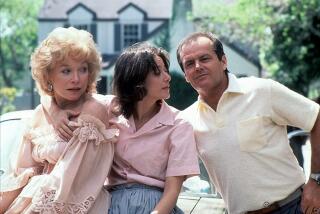A Behind-the-Scenes Look at Sydney Pollack’s ‘Tootsie’
- Share via
One way to destroy the pleasure of seeing a good film is to dissect the life out of it. But watching well-done laser disc releases of films with intelligent explanatory tracks and supplementary materials can help you understand the complexities of filmmaking, and make you marvel at how the good ones came together at all.
A new letterboxed Criterion release of the 1982 comedy “Tootsie” ($80, CLV, CAV, digital audio sound) comes close to providing that experience. Described during production as “troubled” because of clashes between star Dustin Hoffman and director Sydney Pollack, it confounded many because it turned out to be that rare bird: a critical and popular success.
It offered an impeccable cast in Jessica Lange (who won a best supporting actress Oscar), Charles Durning, Terri Garr, Dabney Coleman, an uncredited Bill Murray and Geena Davis in her first part.
Pollack’s audio track is illuminating. He talks about his differences of opinion with Hoffman; how the film went through seven writers, including the uncredited Elaine May, as well as the credited Larry Gelbart and Murray Schisgal; how Hoffman insisted on casting Murray even though Pollack was unfamiliar with his work; how May defined Garr’s character and created Murray’s; how Pollack cast Lange after his daughter insisted he watch her in the 1976 remake of “King Kong.”
Pollack’s recollections parallel much of his conversation during the making of the film, shown in Rocky Lang’s poorly made, promotional, choppy documentary “The Making of Tootsie.” Particularly frustrating is the insipid music used to underscore interviews--”The Way We Were” from Pollack’s earlier film, Al Jolson’s signature song “Toot, Toot, Tootsie”--for all it does is obscure what’s being said. And, unfortunately, our only perspective on Hoffman comes from these decade-old conversations. Hoffman, according to a Criterion spokesman, was still involved with “Hook” and “Billy Bathgate” and unable to participate on the Criterion project.
Lang does capture Pollack in a revealing moment of introspection: “I’m 47 years old and I have to accept the fact that I’m probably not going to set the world on fire. . . . If I was going to do that, I would have done it by now. . . . When you first start out you want to be Fellini, or you want to be Bergman. The best you can say about it is that you went farther than you thought your were going to go, realistically anyway.”
Pollack’s remembrances of the “respectful and friendly war” he and Hoffman waged offer some insight, albeit one-sided, into the “creative differences” that battle-scar Hollywood. As Pollack tells it, a director can’t really make an actor do anything he doesn’t want to do, and a director, of Pollack’s sensibilites anyhow, can’t really do anything he doesn’t believe in. On this film, they often resolved their differences by repairing to one or the other’s trailer and screaming at each other, then doing it Pollack’s way, according to the director. Hoffman was largely responsible for eventually getting this project to the screen, but how and why isn’t really told on this disc.
Much of the supplementary material offered is a video disc version of Susan Dworkin’s book “Making Tootsie,” which often translates to showing scenes we’ve just seen. This is one time the film would have been better served if we could have read the seven versions of the script on the CAV (standard play) sides, or at least various versions of key scenes, instead.
Whatever the defects of this particular disc, however, this is the kind of movie experience unavailable any other way. The crisp transfer and letterbox format contribute a good deal.
More to Read
Only good movies
Get the Indie Focus newsletter, Mark Olsen's weekly guide to the world of cinema.
You may occasionally receive promotional content from the Los Angeles Times.







